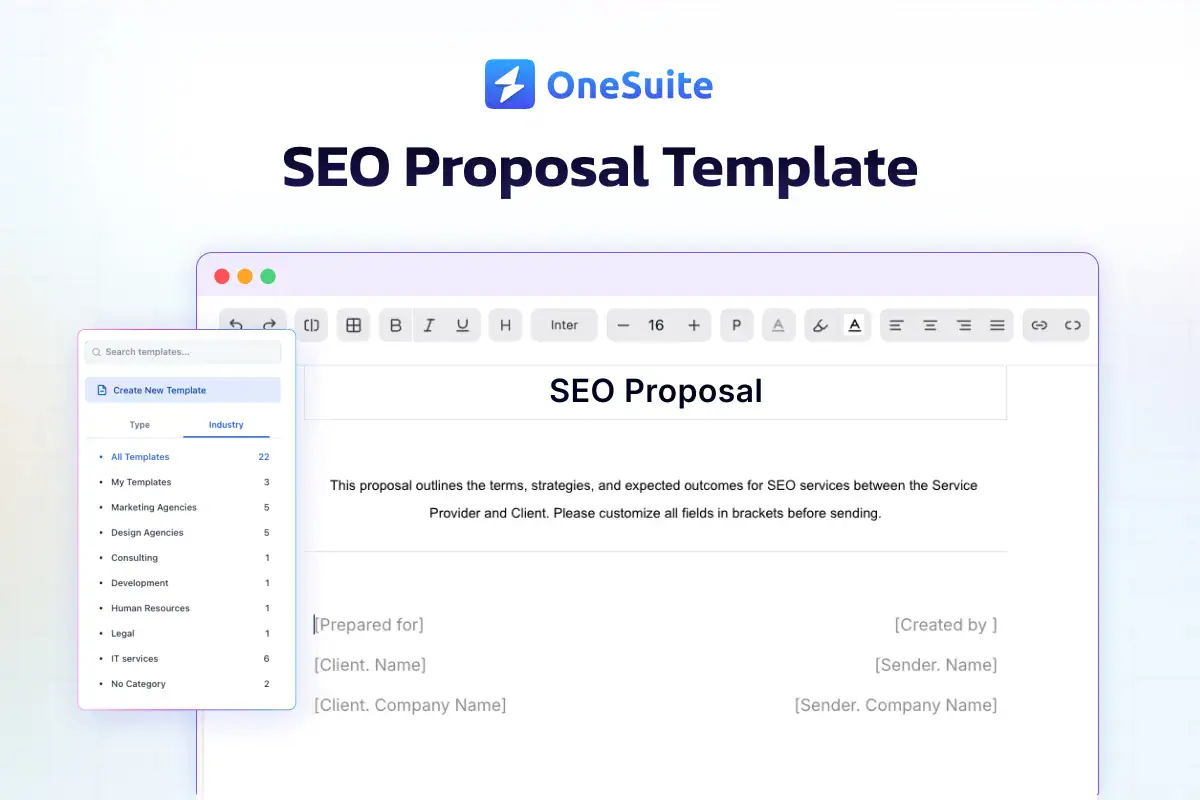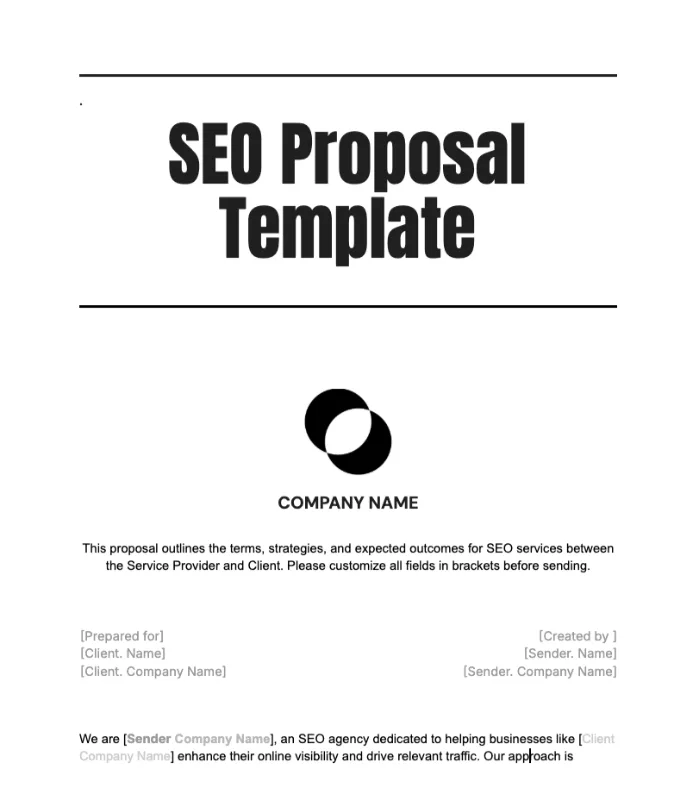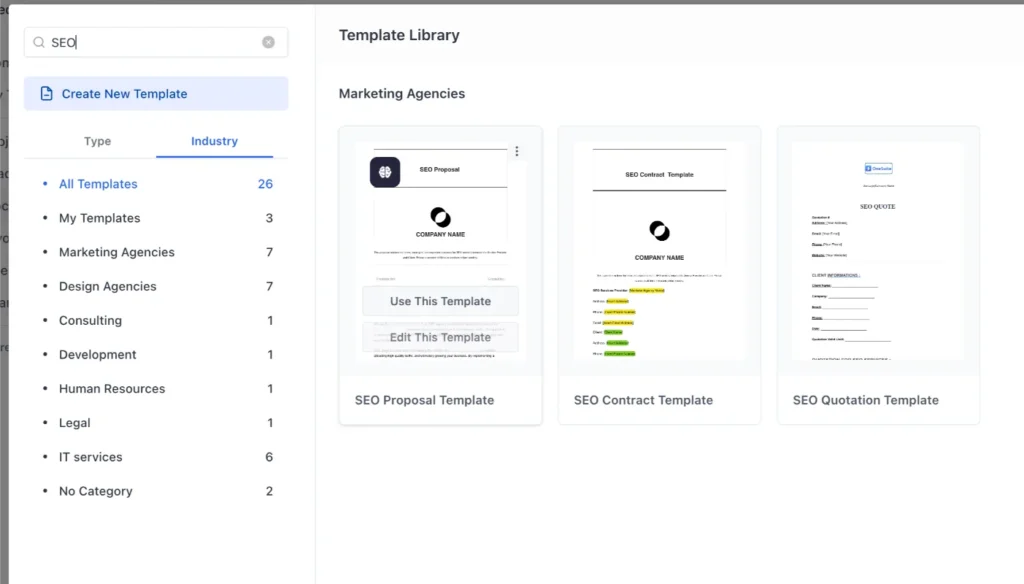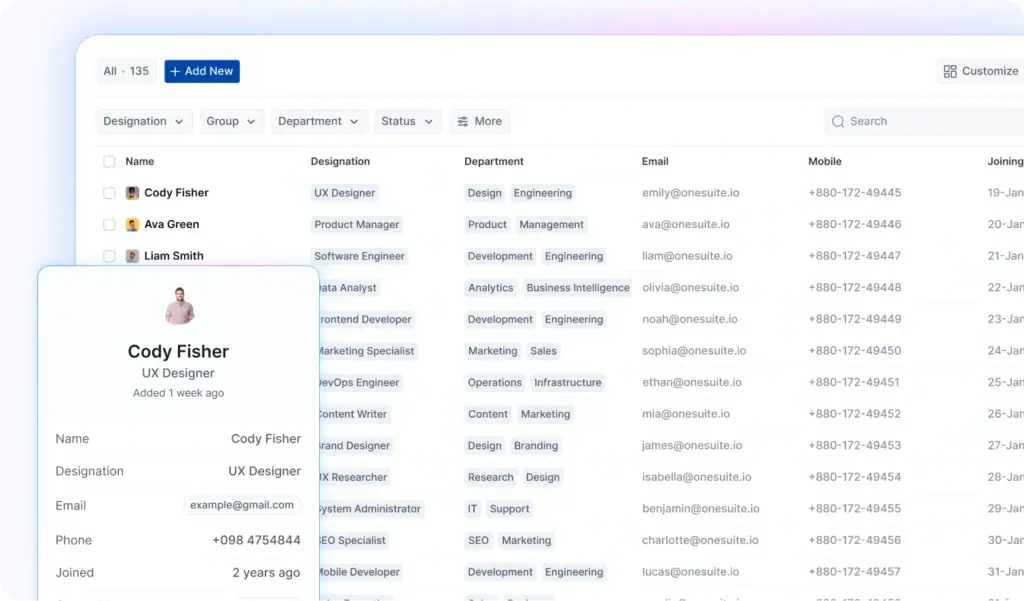
You’ve tried creating SEO proposals for your clients. And chances are it felt slow, confusing, or overly complicated.
We heard this from freelancers, agencies, and marketing teams alike. Sending a clear and professional SEO proposal should be simple. It is meant to show your plan, set expectations, and build trust not make your workflow harder.
That is why OneSuite introduced its free SEO proposal template. With it, you can quickly customize proposals, fill in client details, and send them for e-signature all from one platform.
It keeps your process organized, professional, and easy for clients to understand.
Now you can focus on strategy and results instead of paperwork.
Free SEO Proposal Template
Before we dive in—if you’re here for the contract, go ahead and grab it now:
⚠️ Disclaimer: I’m not a lawyer, and this isn’t legal advice. Always speak to a qualified attorney when drafting contracts.
What is an SEO Proposal?
An SEO proposal is a customized plan that outlines how your SEO services will help a client improve their website’s search engine rankings and visibility.
- Clear Strategy: It shows exactly how SEO will be implemented—covering audits, keyword research, content optimization, and link building.
- Goals & Timelines: The proposal sets clear goals, outlines expected results, and provides a realistic timeline to achieve those outcomes.
- Pricing & Deliverables: It explains the costs involved and specifies the deliverables, so both you and your client are aligned on expectations and outcomes.
An SEO proposal is your way of showcasing your expertise and ensuring the client understands how you’ll help them grow their business.

⚡️See Also : Looking for the perfect marketing project management software? Dive into our guide to discover tools that help you easily plan, track, and execute campaigns.
What to Include in Your SEO Proposal
💡 You don’t have to be a great writer to write a great proposal, but you do have to plan and prepare.” — Adapted from business leadership wisdom
A well-structured SEO proposal clearly shows your client what you will do, how you will do it, and the results they can expect. Including the right sections helps set expectations, builds trust, and makes it easy for clients to understand the value of your services.
In this section, we’ll cover the essential elements every SEO proposal should have.
1. Company Overview
Start your proposal by introducing your agency in a way that shows why you’re the right fit for the client’s SEO needs. Briefly explain your area of expertise, whether it’s on-page SEO, off-page SEO, or a full-service approach.
Highlight your experience with similar industries or businesses so the client knows you understand their specific challenges and goals. Share measurable results from past campaigns, like improvements in organic traffic, higher search rankings, or successful content strategies.
Show that your solutions are tailored to each client. Explain how you take the time to understand their unique goals and create strategies that address their pain points. Express your enthusiasm for helping them grow, and include clear contact details so they can easily reach out with questions.
Keep this section concise, clear, and focused on establishing credibility while connecting with the client personally.
2. Client’s Business Overview
Start by showing that you truly understand the client’s business. Highlight their industry, goals, and the challenges they face in reaching their audience. This section builds credibility and shows you’ve done your homework. Mention the size of their team, their products or services, and any unique aspects of their business.
By framing their current situation clearly, you demonstrate that your SEO strategy won’t be generic—it’s tailored to their needs. This makes the client feel understood and confident that your recommendations will make an impact.

3. Pitch Specific SEO Insights
This is where your proposal becomes personalized and data-driven. Here you show the client you’ve analyzed their current SEO performance and mapped out opportunities for improvement. Include actionable insights that your team has gathered:
- Current keyword performance: Show which keywords they rank for and which high-potential terms you can target for growth. Focus on keywords that drive relevant traffic aligned with business goals.
- Website SEO audit: Highlight critical issues, such as missing meta descriptions, slow page speed, duplicate content, or UX problems. These quick wins reassure clients you can fix major pain points.
- Competitive analysis: Compare their performance to key competitors. Identify gaps where competitors rank but they don’t, showing opportunities for growth.
- User engagement and content relevance: Review content quality, user experience, and engagement metrics to identify improvements that align with SEO best practices.
Make sure the language is simple and client-friendly. Avoid heavy SEO jargon; instead, explain findings in a way anyone can understand. Include screenshots, charts, or keyword reports to show your findings clearly.
A few quick steps you can take:
- Run a keyword ranking check to identify current positions and search volume.
- Include insights on competitor keywords they could target.
- Conduct a technical SEO audit using your preferred tool and summarize findings in the proposal.
Finally, summarize the client’s current SEO health with high-level KPIs and outline your plan for improvement. This section should make the client feel confident that your agency can take their website to the next level.
4. SEO Goals & KPIs
After analyzing a local business’s website and online presence, the next step is to define SEO goals that directly support their local growth. Think of these goals as a map guiding each optimization step and showing clients how your efforts impact their visibility.
For a local business, the main goal could be increasing foot traffic, inquiries, or bookings from nearby customers. Measurable steps make it easy to track progress and demonstrate results.
Key performance indicators to monitor include:
- Local traffic growth – Track visitors coming from your city, region, or neighborhood to see how well the business is attracting nearby customers.
- Google My Business (GMB) ranking – Monitor the business’s position in local map results to ensure maximum visibility in searches.
- Local keyword performance – Track keywords relevant to the business and its service area to ensure the site ranks for terms that drive qualified local leads.
By setting clear goals and KPIs, local business clients can see exactly how SEO efforts improve their visibility, attract nearby customers, and grow revenue. It also provides a structured way to evaluate success and optimize campaigns over time.
5. Proposed SEO Strategy
When presenting an SEO plan to a client, it’s important to start with the big picture. Think of it as giving them a bird’s-eye view of the journey ahead. Instead of diving into every technical detail, focus on the main outcomes you aim to achieve and how they align with the client’s goals.
Begin by analyzing the client’s current website and online presence. Understand what’s working, where there are gaps, and how SEO can make a tangible impact.
Next, link these insights to the client’s business goals, such as increasing local visits, raising their search presence, and growing organic traffic
For Local Businesses:
- Google My Business Optimization.
- Local Keyword Targeting
- On-Page Content Refinement
- Local Citations & Listings –
- Customer Reviews & Ratings
For other businesses, it might involve a combination of content optimization, technical SEO improvements, and link-building strategies. Present these strategies in a concise, easy-to-read format so the client can immediately see the value.
The goal of a high-level SEO strategy is to give the client confidence in your approach. It shows them that you’ve done the research, understand their needs, and have a clear plan to achieve measurable results.
Later, once they approve the project, this overview can evolve into a detailed roadmap with timelines, deliverables, and milestones.
By keeping the language simple, visualizing your strategy with charts or diagrams, and highlighting key actions, clients can quickly grasp how your SEO plan will drive results without feeling overwhelmed by technical jargon.
6. Timeline for SEO Implementation
A well-structured timeline is essential for keeping SEO projects on track and ensuring clients know exactly what to expect. It helps break down the project into manageable phases, making it clear how each step aligns with the client’s goals and when they can start seeing results.
Begin by outlining the key steps in the project, like research, strategy development, on-page improvements, content updates, and link-building.
Each step should have clear goals and deliverables, so the client can easily follow the progress and stay informed throughout the process.
A clear timeline helps manage expectations and keeps the project organized. It ensures tasks are completed on time and in the right order. The timeline also allows flexibility to adjust as new insights emerge, ensuring the client’s goals remain the focus.
7. Pricing & Investment
After showcasing how your SEO strategy will benefit their business, it’s time to discuss the investment needed to make it happen.
I prefer to refer to this as an “investment” rather than just a cost. Your SEO services are designed to grow their business, enhance visibility, and ultimately drive more revenue.
Positioning it this way helps your client focus on the long-term value, not just the price tag. It’s about the return they’ll see from working with you.
It’s tempting to offer a lower price to attract clients, but underpricing can be detrimental to both your business and theirs. Offering a fair and competitive price ensures you have the resources to deliver high-quality SEO work. After all, investing in effective SEO will help them see measurable results.
To make it easier for your client to make a decision, offer tiered pricing. Start by introducing your main package, which includes all the core SEO services discussed.
Then, present two additional options: a more budget-friendly package with essential services, and a premium package that includes additional features for clients who want more comprehensive support.
This way, the client feels empowered to choose the option that works best for them, while still recognizing the value of what you’re offering.
8. Call to Action
Now that we’ve outlined the SEO strategy and how it can drive results for your business, it’s time to take the next step toward achieving those goals. I want to make sure we start this journey together smoothly and efficiently.
See Also: How to write the proposal template for your next project
When to Use an SEO Proposal Template
An SEO proposal template is a practical tool that helps agencies and freelancers communicate clearly with clients. It’s useful in several situations:
1. Client Onboarding: Use a template to explain your services, goals, and process clearly when starting with a new client.
2. Managing Timelines;Templates help set clear deadlines for each project phase so both you and the client know what to expect.
3. Payment Clarity: Outline pricing, payment terms, and milestones to avoid misunderstandings and ensure smooth transactions.
4. Showing Results: Track improvements like traffic, rankings, and leads using the proposal to show progress and outcomes.
5. Protecting Freelancers: Define the scope of work and responsibilities so freelancers are fairly compensated and avoid disputes.
6. Planning the Project: Provide a clear roadmap so clients understand the steps, goals, and deliverables throughout the project.
So, by using the OneSuite SEO proposal template, you can win your client’s trust, clearly outline services, and provide a professional contract.
Grab the free OneSuite SEO contract template and marketing service agreement to make your client experience smooth and reliable.
SEO Proposal Template With OneSuite
OneSuite’s SEO Proposal Template allows you to quickly create and send professional proposals. It’s easy to customize and fill out, helping you get your SEO proposals sent to clients in just a few minutes.
1. Choose a Proposal Template
- Navigate to the Documents section and click on Create from Template.
- Select a SEO Proposal template from OneSuite’s library, which is categorized by type or industry.

2. Customize the Template
- Fill in client details like company name, contact information, and project scope.
- Add pricing, timeline, and terms and conditions.
- Use the editor to personalize text, and include visuals or case studies if needed.
3. Add Signature Fields
- In the left panel, add signature fields for all parties (you and your client).
- Position the fields in the document where signatures are needed, typically at the end.
4. Save and Send
- After reviewing, click Save and then Send to email the proposal.
- Add client email, confirm signers, and customize the email message.
- Click Send Parties to Sign to send the document for e-signatures.
5. Client Signs and Receives Confirmation
- The client will receive an email with a link to review and sign the proposal.
- Once signed, both you and the client receive a confirmation, and the signed document is available for download.
For a step-by-step walkthrough, you can watch this helpful video: “Using the OneSuite Proposal Template: A 5-Minute Guide”.
Frequently Asked Questions About SEO Proposals
How can an SEO proposal help win clients?
An SEO proposal helps win clients by clearly defining your work goals, establishing trust, enabling smart communication, and building a strong professional relationship.
What are common mistakes to avoid?
1. Being vague about deliverables and timelines, which can create misunderstandings.
2. Overloading the proposal with technical jargon that the client may not understand.
3. Not clearly stating pricing or payment terms, leading to confusion or disputes.
Find a Better Way to Grow
OneSuite streamlines projects, clients, and payments in one place, making growth hassle-free.

